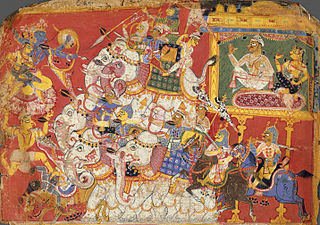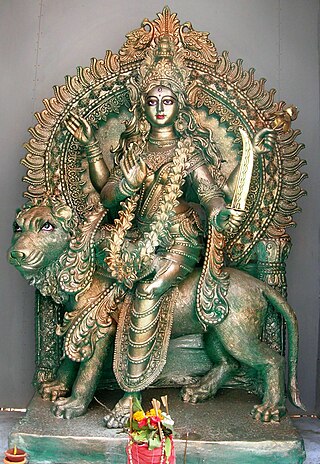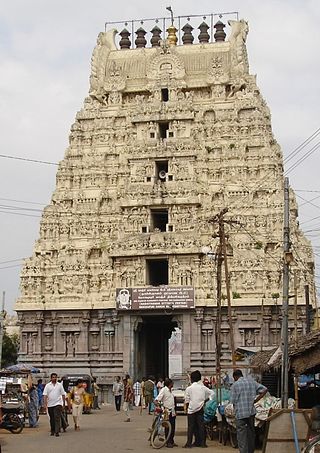
Ardhanarishvara, is a form of the Hindu deity Shiva combined with his consort Parvati. Ardhanarishvara is depicted as half-male and half-female, equally split down the middle. The right half is usually the male Shiva, illustrating his traditional attributes.

Bhavānī is an epithet associated with Adi Shakti (Durga). Bhavani translates to "giver of life," meaning the power of nature or the source of creative energy. She is considered to be a nurturing mother figure who provides for her devotees and also plays the role of dispensing justice by killing evil Asuras.

In the Shaivism and Shaktism tradition of Hinduism, the goddess Tara is the second of the ten Mahavidyas. She is considered a form of Adishakti, the tantric manifestation of Parvati. Her three most famous forms are Ekajaṭā, Ugratara, and Nīlasarasvatī. Her most famous centre of worship is the temple and the cremation ground of Tarapith in West Bengal, India.

Lalita Sahasranama is a Hindu religious text from the Brahmanda Purana which lists the thousand names of the Hindu mother goddess Lalita Devi.

Uthamar Kovil in Uthamarkoil, a village in the outskirts of Tiruchirappalli in the South Indian state of Tamil Nadu, is dedicated to the Hindu Trimurti of Vishnu, Shiva, and Brahma. Constructed in the Dravidian style of architecture, the temple is glorified in the Nalayira Divya Prabandham, the early medieval Tamil canon of the Alvar saints from the 6th–9th centuries CE. It is one of the 108 Divya Desams dedicated to Vishnu, who is worshipped as Purushothaman Perumal and his consort Lakshmi as Poornavalli Thayar.

The Kamakhya Temple at Nilachal hills in Guwahati, Assam is one of the oldest and most revered centres of Tantric practices, dedicated to the goddess Kamakhya. The temple is the center of the Kulachara Tantra Marga and the site of the Ambubachi Mela, an annual festival that celebrates the menstruation of the goddess. Structurally, the temple is dated to the 8th-9th century with many subsequent rebuildings—and the final hybrid architecture defines a local style called Nilachal. It is also one among the oldest 4 of the 51 pithas in the Shakta tradition. An obscure place of worship for much of history it became an important pilgrimage destination, especially for those from Bengal, in the 19th century during colonial rule.

Tripura Sundari, also known as Rajarajeshvari, Shodashi, Kamakshi, and Lalita, is a Hindu goddess, revered primarily within the Shaktism tradition and recognized as one of the ten Mahavidyas. She embodies the essence of the supreme goddess Mahadevi. Central to the Shakta texts, she is widely praised in the Lalita Sahasranama and Saundarya Lahari. In the Lalitopakhyana of the Brahmanda Purana, she is referred to as Adi Parashakti.

Kamakhya, a mother goddess, is a Shakta Tantric deity; considered to be the embodiment of Kama (desire), she is regarded as the goddess of desire. Her abode–Kamakhya Temple is located in the Kamarupa region of Assam, India. Originally a Kirata goddess, Kamakhya remained outside Brahmanical influence until at least 7th century CE. Residing on Nilachal hills across the banks of the Brahmaputra River, west of Guwahati in the 10th/11th century Temple rebuilt in 1565 CE, she is worshiped in a non-iconic and un-anthropomorphic form of stone shaped like yoni fed by a perennial stream. The temple is primary amongst the 51 Shakti Pithas, and is one of the most important Shakta temples.

The Shakti Pithas or the Shakti Peethas are significant shrines and pilgrimage destinations in Shaktism, the goddess-centric denomination in Hinduism. The shrines are dedicated to various forms of Adi Shakti. Various Puranas such as Srimad Devi Bhagavatam state the existence of a varying number of 51, 52, 64 and 108 Shakti Pithas of which 18 are named as Astadasha Maha (major) in medieval Hindu texts.
The Kalika Purana, also called the Kali Purana, Sati Purana or Kalika Tantra, is one of the eighteen minor Puranas (Upapurana) in the Shaktism tradition of Hinduism. The text was likely composed in Assam or Cooch Behar region of India and is attributed to the sage Markandeya. It exists in many versions, variously organized in 90 to 93 chapters. The surviving versions of the text are unusual in that they start abruptly and follow a format not found in either the major or minor Purana-genre mythical texts of Hinduism. Various types of animal sacrifices for devi are detailed in the Purana.

Naraka, also known as Narakasura, was a mythical asura king, the legendary progenitor of all three dynasties of Pragjyotisha-Kamarupa, and the founding ruler of the legendary Bhauma dynasty of Pragjyotisha. Though the myths about Naraka are first mentioned in the Mahabharata, later texts embellish them. According to later post-Vedic texts such as the Brahma Purana and Vishnu Purana, he was the son of Bhudevi, fathered either by the Varaha incarnation of Vishnu or Hiranyaksha. He is claimed as one who established Pragjyotisha. He was killed by Krishna and Satyabhama. His son Bhagadatta—of Mahabharata fame—succeeded him.

Katyayani (कात्यायनी) is an aspect of Mahadevi and the slayer of the tyrannical demon Mahishasura. She is the sixth among the Navadurgas, the nine forms of Hindu goddess Durga who are worshipped during the festival of Navaratri. She is depicted with four, ten or eighteen hands. This is the second name given to the goddess Adi Parashakti in Amarakosha, the Sanskrit lexicon.

The Kamakshi Amman Temple, also known as Kamakoti Nayaki Kovil, is a Hindu temple dedicated to the goddess Kamakshi, one of the highest aspects of Adi Parashakti, the supreme goddess in Shaktism. The temple is located in the historic city of Kanchipuram, near Chennai, India.

Tarapith is a town and Hindu pilgrimage site located in Rampurhat subdivision of Birbhum district of the Indian state of West Bengal. The town is particularly known for its Tantric temple and its adjoining Hindu crematory ground. The Tantric Hindu temple is dedicated to the goddess Tara.

Sutanphaa also Siva Singha was the 31st king of Assam from the Ahom dynasty who reigned from He was the eldest son of King Rudra Singha. Siva Singha was with his dying father at Guwahati, who then proceeded to the capital Rangpur where he ascended to the throne. He is noted for his elaborate system of espionage. He had numerous temples erected and made large gifts of land to them. With his patronage, Hinduism became the pre-dominant religion of the Ahoms. The king was also a patron of music and literature and music and himself composed Sanskrit songs and learnt songs. His reign coincided with the arrival of the first Europeans traders into Assam.

The Ambubachi Mela is an annual Hindu mela (gathering) held at Kamakhya Temple in Guwahati, Assam. This yearly mela is celebrated during the monsoon season that happens to fall during the Assamese month Ahaar, around the middle of June when the sun transits to the zodiac of Mithuna, when the Brahmaputra River is in spate. During this time Brahmaputra River near the temple turns Red for three days.

Dirgheswari Mandir is a temple situated in the northern banks of the river Brahmaputra in North Guwahati, Assam, India. Many ancient images made on rocks existed along with the temple. Brick temple was Built by Ahom king Swargadeo Siva Singha, Dirgheswari temple is considered as a Shakti Peetha for Shakti Worship. The main attraction of Dirgheswari temple is the annual Durga Puja celebrations, in which devotees from far of places use to attend.

The Goddess Ugratara is the tutelary deity of Eastern Ganga dynasty kings of erstwhile Kalinga dynasty. Her ancient temple lies at Mulajharigarh village, Bhusandapur 65 kilometers from State capital Bhubaneswar, Orissa, India. The icon of Mother Tara is three-eyed and Chaturbhuja, holding potent weapons as sword, dagger, blue lotus and a drinking cup in her hands. She stands over a corpse on burning flames of funeral pyre. Serpent anklets and a serpent on crown are visible which clearly dates back to the time of the 11th-century Tantrik text Sadhanamala Tantra. When later kings of Gajapati dynasty revered goddess Kali or Shyamakaali she had less importance and her worship received less attention. But many people belonging to Vasishtha Gotra revere her as Ishta devi. She is one among ten Mahavidya in Hindu Tantrik theology. She is very popular as Ugratara due to her fierce aspect, but benevolent to the adorers as Ekajata/Neela-Saraswati. Nearby railway station is Bhushandapur in Khordha district which is accessible from Bhubaneswar and Balugaon by local passenger trains. The main festivals here are Chaitra parba, Raja Parba, Sharadiya Durga Puja. She is worshipped in tantrik way and offered all tantrik fivefold paraphrenalias.
Shri Shri Mahalakshmi Bhairabi Griba Maha Peetha is one of the Shakti Peeths, at Joinpur village, Dakshin Surma, near Gotatikar, 3 km south-east of Sylhet town, Bangladesh. The Hindu Goddess Sati's neck fell here. The Goddess is worshipped as Mahalakshmi and the Bhairav form is Sambaranand.

















